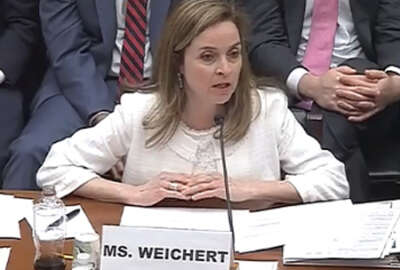
Explaining the mixed messages on 2018 employee engagement
How can two organizations, using the same data, offer up two different takes on employee engagement in the federal workforce?
Margaret Weichert, from her seat as both deputy director for management at the Office of Management and Budget and acting Office of Personnel Management director, said she looks at engagement in the federal workforce and sees a complex picture.
Every agency is different. Each has its own challenges. Some lost top leaders in high-profile shakeups. Some are reorganizing. And others are taking the lead on initiatives embedded in the President’s Management Agenda.
“We have a diverse, complex government workforce, [and treating it] with sort of a one-size-fits all diagnosis around engagement and morale is not doing anyone any service,” she said last Friday in an interview with Federal News Network.
Which is why a series of Tweets that came from the Office of Management and Budget last week about the Partnership’s rankings, perhaps, conveys mixed messages.
So our #federalworkforce gets credit for employee engagement work I am sharing #FedBPTW trend data. Misleading stats on # of agencies (esp small agencies) obscure hard work by agencies @DeptofDefense @CommerceGov @HHSGov @DHSgov to raise engagement @RPublicService #buryingthelead pic.twitter.com/BIpjjJfZ0s
— Margaret Weichert (@Weichert45) December 13, 2018
The Partnership for Public Service, which produces the rankings, uses a proprietary weighted formula that looks at agencies’ responses to three questions in OPM’s Federal Employee Viewpoint Survey (FEVS). The Partnership uses this formula to then rank each agency in groups based on the organization’s size.
Partnership President and CEO Max Stier has since clarified its method on multiple occasions since last week’s tweets.
The Department of Veterans Affairs, which used some but not all questions from the FEVS to conduct its own viewpoint survey in 2018, wasn’t included in the Partnership’s overall assessment of employee engagement.
OPM’s top-level assessment, which it released in October, did include VA.
And it’s for this reason, that two organizations — using the exact same data — can offer up different and broad views on employee engagement over the past year.
The governmentwide data from OPM shows engagement is up. The Partnership’s data shows it’s down.
A nuanced look at engagement
But really, as both Weichert and the Partnership have said, the message is more complicated.
On one hand, there are some agencies — the Defense Department and the Department of Homeland Security — which are the largest and third-largest departments in government, respectively — that did make some strides over the past year.
Most notably, the Office of the Secretary of Defense, Joint Staff, defense agencies and DoD Field Activities together improved employee satisfaction by 2.1 percent in 2018.
DHS continued its trend in the right direction with a 1.1 percent increase. DHS subcomponents saw bigger improvements, with the Secret Service boosting engagement by 11 percent in 2018.
It’s these improvements that Weichert said she wants to highlight to the public.
“The thing that is really instructive is to actually look at the players that made the biggest moves,” she said. “A lot of the reporting addressed very tiny moves that are almost statistically meaningless, especially for small agencies. Whereas if you have a two-point move in a large agency, that’s a profound and meaningful indication that something is really happening there.”
DHS and the Secret Service have been focused on taking a holistic view of employee engagement over the past year.
Weichert pointed to the Government Accountability Office, which fell from an 82.5 percent engagement score in 2017 to 80.7 percent in 2018. Declines at smaller agencies like GAO, she said, aren’t as statistically relevant as the strides she sees at larger organizations.
But there other agencies, organizations larger than GAO, that suffered some dramatic plunges in 2018.
The Partnership also pointed to a statistic that the casual observer wouldn’t immediately find in OPM’s release of the governmentwide viewpoint survey results: Employee satisfaction fell at 59 percent of agencies in 2018, while 40 percent saw improvements.
It’s a stark contrast to the recent past, when more than 70 percent of federal organizations made improvements over the past three years, according to the Partnership.
“When you look at issues of engagement, some of the issues may be very intractable, and they may not be within an individual leader’s power to address them,” Weichert said.
She acknowledged the lower scores at agencies like the Agriculture Department, which has been the poster-child for the administration’s IT modernization efforts and has been reorganizing some of its subcomponents.
“They’re doing the difficult work of investing in IT modernization activities,” Weichert said of USDA. “I would expect, and this is not different in the private sector, that at the beginning of any change that represents a significant one, you do see a dip in engagement scores, because there’s uncertainty. Particularly in government, the idea of change is always around but rarely achieved. There may be a trust issue.”
Weichert said she’d expect to see more positive results of the work that Deputy USDA Secretary Stephen Censky is doing to solicit feedback from his agency’s employees in next year’s viewpoint survey.
Agencies should adopt a similar model, she said, and solicit feedback from their employees and members of the public about the changes they’re making to modernize operations.
That method will win back the public’s trust — and the trust of their employees, she said.
“It engages the employee not for an end in and of itself, but for an end that is a higher purpose,” Weichert said. “It’s about the mission of serving veterans or farmers or retirees or whatever the mission actually is. That’s the place where we can win hearts and minds. because we do share a common goal of serving the American people.”
Copyright © 2024 Federal News Network. All rights reserved. This website is not intended for users located within the European Economic Area.
Nicole Ogrysko is a reporter for Federal News Network focusing on the federal workforce and federal pay and benefits.
Follow @nogryskoWFED





